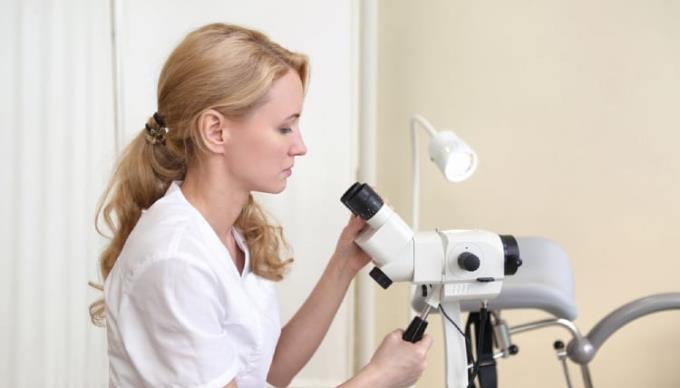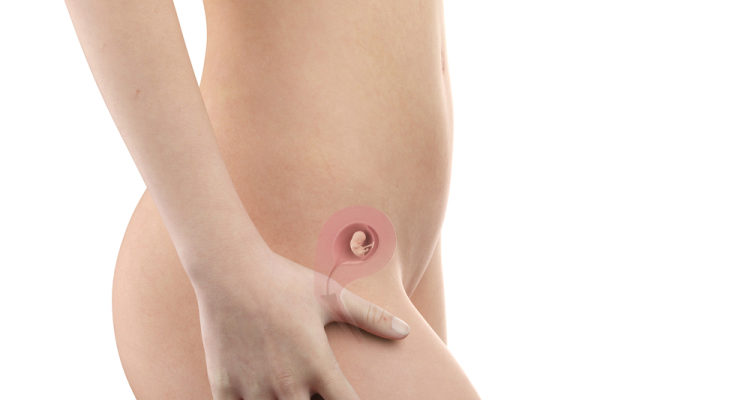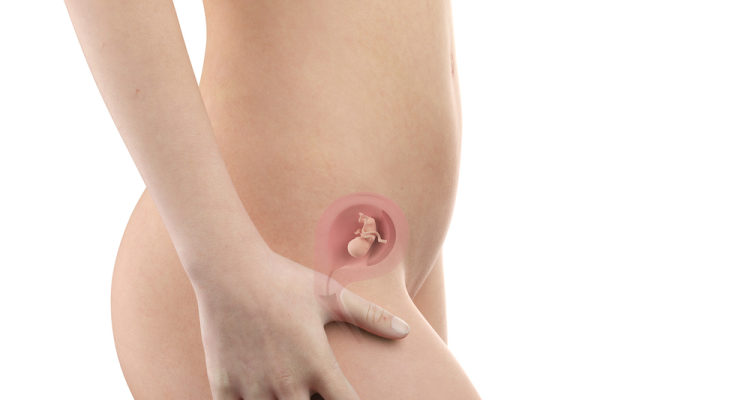Unlike most other types of cancer, cervical cancer can be completely cured if it is found early and intervened in time.
In many countries nowadays, a diagnosis of cervical cancer is made before counseling is offered to pregnancy. Thereby reducing the risk of pregnant women having this condition, and ensuring pregnant mothers have a healthier pregnancy.
In essence, early cervical cancer does not affect the fetus or even the birth. However, treatment is believed to be essential. Because, people have noticed some negative effects on the mother in the later progression.
Troubleshooting: What is cervical cancer?
The cervix is part of the female genitalia, the connection between the vagina and the uterine body. Cervical cancer is a malignant pathology of the slice epithelium (squamous epithelium) or cervical adenoma.
It starts when cells in the cervix grow, multiply uncontrollably, invade surrounding areas, and spread to other parts of the body.
In some cases, these cancer cells can multiply extremely rapidly at a certain stage within a year. Conventional reports mean, meanwhile, that it takes years for cells to transition from a precancerous stage to cancer.
The prevalence of cervical cancer today
Cervical cancer growth rate during pregnancy is low. According to statistics, only about 3% of cervical cancers are diagnosed during pregnancy. In the United States, more than 11,000 mothers are diagnosed with the disease each year.
Stages of cervical cancer

Stages of cancer are diagnosed based on the extent to which tumor cells proliferate and spread in the cervix. Here are the most common stages of the disease:
1. Stage 1
This is the earliest stage that can detect cancer in the cervical area. It is divided into two sub-stages as follows:
Stage 1A : At this stage, the growth of cancer cells is very small and is only found on examination under a microscope.
Stage 1B : In this stage, the cancer cells are located in the cervical tissues but they have not spread to other internal organs.
2. Stage 2
At this point, cancer cells begin to spread out from the cervix to surrounding healthy tissues. Stage 2 is also divided into two sub-phases:
Stage 2A: Cancer cells spread to the top of the vagina
Stage 2B: At this point, the cancer affects the tissues around the cervix.
3. Stage 3
This is the time when cervical cancer develops from the cervix to the surrounding structures of the pelvic region. It is divided into:
Stage 3A: Cancer spreads to the lower area of the vagina
Stage 3B: Cancer develops around the pelvic wall and blocks the kidney's drainage pipes.
4. Stage 4
Stage 4 is the last stage in the progression of cervical cancer. That is when the cancer has spread to internal organs outside the uterus. This phase is divided into:
Stage 4A: Cancer has spread to nearby organs such as the bladder and rectum
Stage 4B: Cancer spreads to organs far away from the uterus, such as the lungs ...
Symptoms of cervical cancer in pregnant women
Pregnant mothers who have cervical cancer during pregnancy will often have the following symptoms:
Pain after sex
Pain in the lower abdomen and pelvis
Abnormal vaginal discharge
Abnormal vaginal bleeding while douching, having sex ...
Causes of cervical cancer during pregnancy

With a normal healthy person, cells are always in balance with proliferation and death. However, once cell destruction is stopped, cells rapidly proliferate and disrupt the balance. From there, they cause abnormal growth that leads to accumulation in the cervix and eventually develop into tumors. These tumors then progress to cancer and lead to cervical cancer.
There are several causes of cervical cancer during pregnancy, such as:
Have sex with many different sex partners
Have sex soon
Weakened immune system
Have HIV or AIDS
Have behaviors such as drinking alcohol or using drugs
Have a long-term stress problem
Have been pregnant many times before
STDs ( sexually transmitted infection ) such as chlamydia, gonorrhea and syphilis
Early pregnancy (usually before age 17)
Smoking
Take birth control pills
Human Papillomavirus (HPV) infection - The virus that causes papillae in humans
There are 100 types of HPV infection and 13 of them are known to contribute to the development of cervical cancer.
Methods of diagnosis of cervical cancer during pregnancy

1. Initial screening tests
Depending on your age and clinical situation, your doctor may prescribe either or both of the following tests:
Tests Pap test ( Pap smear ): Doctors use a speculum to observe the inner area of the cervix. The doctor will then use a soft brush or wooden stick to take cervical cells for testing.
Test for HPV (Human Papillomavirus) - human papilloma virus: This is considered an important test in the prevention of cervical cancer. This is because persistent HPV infection is known to lead to cervical cancer.
2. Tests that help confirm the diagnosis
Depending on the results of the two tests above, your doctor will order 1 or all of the following tests to confirm the disease:
Colposcopy: Use a scanner to enlarge the image of the cervix to look for abnormal cells. If abnormal cells are found during the colonoscopy, the doctor will press a biopsy of the abnormal spot to take the tissue for testing.
Cervical biopsy: Use a special press to take a small tissue sample to test for pathology. This procedure is usually painless but can cause bleeding.
Cervical canal: Use a small, special cervical- sized spoon to scrape some tissue in the canal area located in the neck to take tissue for histological examination.
3. Cervical tissue biopsy
In the case that doctors detect cervical cancer, additional forms of diagnosis will be made to determine the stage and extent of cervical cancer. Common diagnoses include:
Imaging tests - X-rays, CT scan, magnetic resonance imaging (MRI), and positron tomography (PET) scan to determine how far cervical cancer has spread.
Visual Examination: Using an endoscopic diagnostic method that scans the area inside the bladder and rectum to check the extent and effects of cervical cancer.
Treatment after diagnosis depends on the severity and spread of the cancer. For mild conditions, regular follow-up and repeated Pap tests are required to continue to check. In contrast to the more severe condition, treatments such as cryotherapy, electrocautery, laser or apical removal of the cervix may be used.
After treatment, patients should be followed up with either a repeat Pap test or a HPV DNA test within six to twelve months.
Will chemotherapy affect the fetus?
The chemotherapy given in the first trimester of pregnancy is harmful to the fetus, because the baby's organs are slowly forming and developing. Chemotherapy does not affect the baby during the second trimester because the placenta acts as a barrier to protect the baby from chemotherapy side effects, while also preventing some drugs from entering the baby's bloodstream.
In the later stages of pregnancy, chemotherapy can indirectly harm the fetus by causing side effects in the mother.
Risk factors associated with chemotherapy treatment include:
Loss of fetus
Birth defects
Low blood cell count during birth
Increased risk of cervical infection
Treatment Options for Pregnant Women with Cervical Cancer
Alternative treatment options for chemotherapy can include:
Chemotherapy combined with radiation therapy
Use certain herbs and vitamins
Change your diet
Acupuncture and massage ...
You should consult with your doctor or relevant medical professional before choosing any alternative treatment. Because depending on your medical condition, some methods may not be suitable.
Treatment for cervical cancer is based on the different stages of pregnancy
Treatment for cervical cancer will be based on the location of the tumor, the stage of the cancer, your overall health, and the stage of your current pregnancy. Below are the treatment regimes for different stages of pregnancy for pregnant women with cervical cancer:
1. The first stage of pregnancy
Routine Pap smear tests are done in the early stages of pregnancy. Surgery that may be performed during this stage involves removing the tumor and healthy tissue around the cervix. This type of surgery is non-invasive and poses little risk to mother and baby.
If your cervical cancer is in an early stage, your doctor may delay postpartum treatment if there aren't any threats to your pregnancy.
2. Second and third trimesters
Your doctor may combine chemotherapy with radiation therapy to provide the treatment you need during this period. These treatments are usually safe and will not harm the fetus during the second and third trimesters.
3. A pregnant woman found to have a small tumor
For small tumors, there are two treatment options available to pregnant women: cervical apical removal or surgical removal of part of the cervix. Since cervical removal is potentially a risk to the fetus and can cause miscarriage during surgery, it should be avoided during pregnancy.
It is for this reason that apical cutting is the more used method. In this method, a piece of tissue is removed from the cervix for examination and diagnosis.
4. Pregnant women have large tumors
Your doctor will recommend chemotherapy for large tumors. You will be advised to choose a premature birth or wait until the second or third trimester to begin this treatment.
Preventive measures for cervical cancer

There are many different measures to prevent cervical cancer, the most common being:
Use a condom when you have sex
Avoid having sex early or not having sex with many different people
Stop smoking or misusing certain drugs
Avoid skin-to-skin contact with someone known to have the virus
Routine HPV vaccine shots start at age 9 to 12 years
All cases should have a Pap test (Pap smear) or periodic HPV DNA test to detect early signs or symptoms of cervical cancer. Vaccination is even recommended for people who have sex with many different subjects to prevent precancerous stages from developing.
Practicing a healthy lifestyle, don't smoke and should limit sex before age 21. This can help minimize the risk of cervical dysplasia . Routine vaccinations are also a way to avoid this and also prevent the spread of HPV.
During treatment, you can ask your doctor for palliative care, which is known to provide pain relief and limit other serious symptoms of the disease.
It is advisable to consult a specialist regarding participation in cervical cancer screening tests. In case of unfortunate cases, you should discuss with your doctor to come up with the best solution to ensure the safety of both yourself and your baby!
You may be interested in the topic:
Postpartum uterine sputum: A dangerous condition for a mother after giving birth
What is the process of a cesarean delivery?
Headache after cesarean section: Causes and solutions















